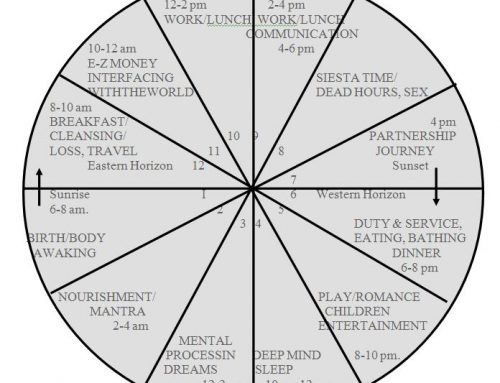6. Go Fast
Humans are built to fast. Ṣleep is a fast from wakeful awareness just as night is a fast from day. Fasting is the engine that drives Nature’s cycles, both within and without our bodies. Even breathing is a cycle of fasting and feasting- gorging on oxygen and doing without. The better we become at fasting, the longer we live. This includes fasting from air (by practicing prāṇāyāma), and from sensual gratification and sex, which builds strength and immunity. The reason many popular diets work is because of the fasting principle- from Adkins (a fast from carbohydrates) to vegetarianism and veganism, which fast from animal products to various degrees. Understanding nature’s cycles will not only make you healthy, it can help you balance your inner world.
योगश्चित्तवृत्तिनिरोधः yogaś citta vṛtti nirodhaḥ
This famous quote from the Yoga Sūtras states that yoga is the cessation of the fluctuations of the mind stuff. The ‘mind stuff’ cited here includes physical sensations as well as mental chatter. When we fast, we give the GI tract a break, which allows our bodies to detoxify and rest. Think of your digestive system as a dishwasher or laundry machine. Can you really know silence if it’s constantly churning, spinning and gurgling, all day every day? The same holds true of your digestion: you cannot have citta vṛtti nirodhaḥ– peace of mind if your belly is full, which is why yogis emphasize a light diet as well as purification practices like enema, prāṇāyāma, and nauli to keep the gastrointestinal tract clear and vritti free. While we cannot all live a yogic lifestyle, we can incorporate some of their best practices into our daily lives. The foremost of these is fasting.
Fasting once a month, or even once a week promotes clarity- not just in the body, but the mind as well. When our stomachs are not busy churning away at the latest greasy meal, our attention becomes more settled, our awareness subtler. We begin to see the quiet beauty in nature in ways that may have eluded us before. The fall of a leaf, the language of animals, and nature’s signals all become clearer, sharper, as we bridge and connect to a deeper part of ourselves. Inspiration comes like a sweet breath moving through us, filling us with intimations of our immortality. This is the spirit, and its subtlety is difficult to perceive. Only when we have silenced our minds can perspicacity glimpse this most elusive of realities.
You can fast on the day that’s most convenient for you- Saturday or Sunday works for most people. Or, you can choose one with special meaning, like the day of your birth or your planetary period.* During fasting, you typically don’t have the same energy you normally do, which is why you should devote the day to rest- allowing your body to catch up and heal itself. Aside from resting, easy walks in nature, playing or listening to music, or any light, inspirational activity will allow your body, mind, and soul to reset and get ready for the week or month to come.
* Saturday is a special day for fasting because it is ruled by the planet Saturn, which rules penance and humility. Your planetary period is your Life Cycle, which is indicated in your Vedic Life Map.
This periodic self-reset through fasting is known to improve longevity- actually slowing down the aging process- as well improving memory and brain function, blood sugar levels and insulin sensitivity* and other physical markers. For people who are not used to it, fasting can be incorporated in a number of ways. Let’s say you’ve chosen Saturday to fast. You can do one of the following:
a. Fast for 24 hours- from Friday’s dinner to Saturday’s dinner.
b. Fast the entire Saturday- from Friday’s dinner to Sunday break-fast.
c. Fast from Sunrise to Sunset- do not eat on Saturday until after the sun has completely set. Sunset times can be found in your local newspaper… or by looking outside!
The third option is usually the most popular (especially during shorter winter nights!) but you can fast any way you like. Fasting is part of many spiritual traditions and for good reason- it promotes health and spiritual awareness. Even the three square meals diet plan is a fast from snacking, which is why it works so well. Try it sometime and you too will be a believer!
*Obviously, if you are diabetic or have a health condition which prevents you from fasting regularly, please abstain- and see a physician to know if periodic fasting is right for you
7. Punch Your Karma
If you’ve lived with āma for a long time, it has probably penetrated into your deeper tissues, disrupting cellular function and accelerating aging. The āma-destroying plan enumerated in these posts will keep new toxins from forming and slowly begin eliminating deeper sludge, but if you want a jump-start dislodging it at the cellular level, get pancha karma– Āyurvedic detox at least once a year. In addition to making you feel light and clean, it adds life to your years and years to your life. Pancha karma (“PK” for short) means five actions relating to its five main therapies, though in practice PK employs multiple weapons to rid the body of morbid toxicity and return it to youthful vitality, including diet, lifestyle, massage, a customized herbal regimen, steam therapy, shirodhārā, enema, and other techniques specific to your mind/body type. Think of it as the deepest spa therapy you’ve ever had.
PK is best done by specialists in a qualified pancha karma clinic but you can do a simple version of this at home. Dr. John Douillard’s Colorado Cleanse details a well-researched and tested home program that works, and you can learn more about it on his website, www.lifespa.com or by buying his book of the same name. Dr. Vasant Lad also details how to perform a classic home PK in his book (already recommended) The Complete Book of Ayurvedic Home Remedies. (Just reading its reviews on Amazon is inspiring!) Both are must-haves if you want a deeper understanding of the body’s dharma.
If you do home PK, do it during spring and fall seasons, six months apart. A full PK lasting two to four weeks can also be performed at professional PK clinics in the USA and India. Participants of a full PK regimen often report feeling younger, more vital, and energized on a deep, cellular level. If you have the time- even if you don’t- make time for a two week or even one month home or clinic PK retreat at least once a year. Your body will thank you for it.







You must take in consideration the primary dosha of the individual and whether or not fasting is appropriate. Kapha people do best with fasting, while Pitta people have a hard time since their agni (digestive fire) is so high. Pitta people may not need to fast, but more so eating a lighter diet. To a Vata person, eating three meals in one day is very much like fasting because their digestion is so variable!
Thanks for the comment, Lois! It is a bit of a misconception that only kapha people can fast successfully. In India as at home I have witnessed Vata, Pitta and Kapha types fasting successfully once a week or even more for years on end- with the only side effect being better health, energy and longevity. From an evolutionary standpoint, humans have been fasting and feasting for the last 100,000 years- kaphas, vatas and pittas alike. Food overabundance is only a product of the last century and a half with the advent of the industrial revolution. But specific to your comment that pittas and vatas are less likely to enjoy fasting, we must look not to VPK, but to the type of metabolism (agni) commonly associated with each type, namely vishama agni (variable, unquiet) with Vata, tikshna (sharp) agni for Pitta and manda (dull or slow) agni for Kapha. All of these agnis are DIS-EASE- states of imbalance, and they can live in any body type- vata, pitta or kapha. I have seen not a few Pittas with manda or vishama agni. I have seen Vata folks with manda agni and Kaphas with tikshna agni.
The point is that these metabolic responses are all imbalances. The Pitta person’s sharp fire does not mean he or she can digest and absorb what they eat- in fact quite the opposite. Tikshna agni is just as likely to create AMA as the others. The headaches, irritability and hypoglycemia tikshna agni people (notice I didn’t say Pitta people!) experience is not a sign of health, but a marker of disease. Therefore it is important to kindle healthy metabolism- called SAMA AGNI- in every body type!
One way to do that is through fasting. Granted, this practice is not for everyone- and many people will need to do it with care, by taking herbs, teas and allowing their bodies to get used to the practice. Having only juice, or a mono fast on one food like apples is a great way to fast for a day. Another segue into regular fasting is the 3 Meals A Day plan- since you teach your body to go longer between meals without crashing.
Do not let the VPK model be a source of limitation, but a tool for inspiration! Remember that the word “dosha” means “flaw” or “pathogenic factor”. The real goal of Ayurveda is to kindle healthy agni. A person with balanced (SAMA) agni can eat pretty much whatever they want- and the ultimate goal of Ayurveda is to awake in us an ability to enjoy the world, not be limited by it!